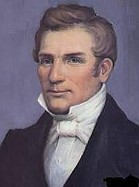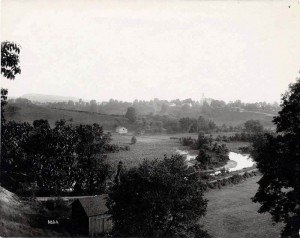In adulthood, Hyrum Smith was described as being five feet, eleven inches tall and as weighing about 190 pounds. He and Joseph were of similar builds and very much resembled each other physically. They were also completely devoted to each other in the gospel. John Taylor, the third president of the Church, described Hyrum in the following way:

Hyrum Smith
“[He] is a man of sterling integrity, deep penetration and brilliant talents. He is well versed in politics and [is] as unchangeable as the everlasting hills. He is a man of probity and virtue, and an unwavering patriot.” After Hyrum’s death, Taylor said of him, “If ever there was an exemplary, honest and virtuous man, the embodiment of all that is noble in the human form, hyrum Smith was the representative” (Hyrum Smith: A Life of Integrity, Jeffrey S. O’Driscoll, 251).
Being the brother of Joseph Smith, Hyrum often does not receive quite as much recognition now as does the Prophet. However, Hyrum lived a life of perfect integrity and sacrificed just as much as Joseph did for the sake of the gospel of Jesus Christ. Joseph would surely be the first of many to praise Hyrum’s unassuming dedication to the gospel and to the building of the kingdom of God on the earth today. Examining Hyrum’s life a bit more closely reveals a hero who is still an example to those of us living today.
Birth and Growing Up Years
Hyrum Smith was born to Lucy Mack and Joseph Smith Sr., on February 9, 1800, in Tunbridge, Vermont. Hyrum was the Smiths’ third son, but the oldest died at birth. Alvin, to whom Hyrum became very close, also died young, at the age of 25, on November 19, 1823, admonishing Hyrum to take care of the family as the now oldest son living. Joseph Smith Jr. was born nearly six years after Hyrum on December 23, 1805.
Hyrum attended Moor’s School in Lebanon, Connecticut, in 1811, which he attended for a couple years as a promising student. However, an outbreak of typhus fever caused him to have to return home in 1813. The entire Smith family soon became infected and thirteen-year-old Hyrum tried to provide what comfort he could to them. After Joseph’s apparent recovery from the illness, however, it became apparent that complications from his illness had led to a severe infection in his leg which required surgery. It was weeks before they found a doctor willing to operate without amputating, and Hyrum, seeing how exhausted his mother was from caring for the family, offered to tend to seven-year-old Joseph. Lucy described Hyrum as sitting by Joseph’s side “almost day and night for some considerable length of time holding the affected part of [Joseph’s] leg in his hands, and pressing it between them, so that his afflicted brother might be enabled to endure the pain which was so excruciating” (Hyrum Smith: A Life of Integrity, Jeffrey S. O’Driscoll, 7). Even then, Lucy noted Hyrum as “rather remarkable for his tenderness and sympathy.”
In 1820, when Joseph was fourteen years old, he had a vision of God the Father and His Son, Jesus Christ, which he eventually shared with his family. The bond between the brothers was strong, and Hyrum never doubted that Joseph had seen and heard what he claimed he had. They were still a poor, hardworking family, though, and all the Smith children developed strong work ethics. Alvin’s death in 1823 was the first of many losses in Hyrum’s life which he used to show empathy to those around him. He was never too busy to comfort someone who had suffered a loss.
Despite constant hard work, the Smith family suffered several financial setbacks. After Hyrum had left home, his family lost their home. He and his first wife, Jerusha, welcomed the whole family in to their small log house. Hyrum was sufficiently educated to qualify him to teach school, which he did at different times to help support his family. His flawless and unquestionable character was enough recommendation to grant him acceptance into the Mount Moriah Mason Lodge No. 112.
A Witness to the Book of Mormon
Though The Church of Jesus Christ of Latter-day Saints had not yet been organized, persecution had already arisen against the Smith family and any who believed Joseph’s story. In 1827, Joseph was entrusted with the plates from which the Book of Mormon would eventually be translated. When people heard rumors of these gold plates, they tried every means to get them from Joseph (though they supposedly discredited everything Joseph said, they apparently still believed in the plates) and persecution intensified. As Joseph translated the plates, with Oliver Cowdery acting as his scribe, they came across doctrines which they would approach the Lord about in prayer. Baptism was one of these ordinances. After receiving the priesthood, Joseph and Oliver baptized each other, and Hyrum was baptized in early June 1829. Early in July, Hyrum and seven others—together known as the Eight Witnesses—were invited to share Joseph’s burden in being a witness of the plates and of the divine origin of the Book of Mormon.
Hyrum was always in tune with the Spirit of God. This sometimes led to promptings and impressions which enabled Hyrum to sense danger and confront it. While the Book of Mormon was being printed, one Sunday afternoon, Hyrum had a distinct feeling that something was not right at the printing office. He confided his feelings to Oliver Cowdery, who was hesitant to go to the office, because it was Sunday and the office was closed. Hyrum acted quickly, however, and upon arriving at the printing office, discovered a man with hostile feelings to Joseph Smith printing his newspaper with excerpts of “Joe Smith’s Gold Bible.” The man had special permission to use the office on Sunday, but was breaking the law printing copyrighted material he found in the manuscript for the Book of Mormon. Hyrum and Oliver finally persuaded the man to cease his printing, thus preserving the integrity of the Book of Mormon. This is one example of many of Hyrum following the promptings of the Spirit.
With the organization of the Church in 1830, Hyrum was told his duty would be unto the Church forever (D&C 23:3). He was also counseled to continue learning the gospel before preaching it, being told he would be called to preach when it was time (D&C 11:15). Hyrum’s commitment to the gospel was such that he would set aside whatever he was doing to help an individual grow in the gospel. Parley P. Pratt sought baptism at Hyrum’s hand and Hyrum welcomed him into his home and discussed teachings of the gospel into the night. Hyrum even walked twenty-five miles with Parley the next day to see him baptized by Oliver Cowdery. At another time, Hyrum was told by a father whose daughter wanted to be baptized that whoever baptized her a Mormon would “do so at his peril.” Hyrum replied respectfully but fearlessly, “Mr. Tyler, we shall not baptize your daughter against your wishes. If our doctrine be true, which we testify it is, if you prevent your daughter from embracing it, the sin will be on your head, not on ours or your daughters” (Hyrum Smith: A Life of Integrity, Jeffrey S. O’Driscoll, 73). Mr. Tyler pondered this, decided to counsel his daughter, and left the decision up to her. She was baptized soon thereafter.
The Kirtland Temple and the School of the Prophets
In 1833, Joseph received a directive for Hyrum from the Lord counseling him and the brethren to build a house of the Lord and to form the School of the Prophets for the instruction of all Church leaders. In the course of the School of the Prophets, the Word of Wisdom was revealed to Joseph Smith. Though the Word of Wisdom did not become a strict commandment for many years, Hyrum remained a strong advocate of following the Lord’s counsel in this matter for the rest of his life.
In June 1833, brethren gathered to discuss the construction of the temple they had been commanded to build. After some deliberation of their own ideas, Joseph revealed to them the plan the Lord had given him. They immediately set to work clearing the ground which had been set aside for the building. Hyrum ran to his parents’ house and grabbed a scythe. On his way back out, his mother asked where he was going with the scythe. His response, as recorded by Lucy, shows his typical zeal and dedication to the work: “We are preparing to build a house for the Lord, and I am determined to be the first at work.” After the men had cleared the grain from the field, Lucy went on, “Hyrum commenced digging a trench for the wall, he having declared that he would strike the first blow upon the house” (Hyrum Smith: A Life of Integrity, Jeffrey S. O’Driscoll, 86).
Hyrum was a strong example to the men in Zion’s Camp on their trek to help their fellow Saints in Missouri. When members of the camp began to complain that others were not working as hard as they ought, they were shown the error of their ways by Hyrum’s firm but gentle counsel. After being shown how murmuring affected the camp, one brother recalled, “We saw the evil, felt humble, and readily confessed to each other and to God and with uplifted hands covenanted to forget and forgive all that had passed and [to]do so no more” (Hyrum Smith: A Life of Integrity, Jeffrey S. O’Driscoll, 97). The men viewed Hyrum as an authoritative leader. Hyrum’s example also enabled him to reprimand the men without being a hypocrite; all Church members felt this and respected Hyrum for it. Upon the men’s return from Zion’s Camp, work on the temple began again.
In all the service Hyrum gave the Church, he was supported by his wife, Jerusha. He was often gone for extended periods on Church business and missions, but she never complained. They had also lost a daughter, Mary, when she was a toddler. They both sacrificed a great deal for the Church. In 1835, the Quorum of the Twelve Apostles was formed, as was the Quorum of the Seventy. Nearly all these men were chosen from the ranks of those who had served under and learned from the Prophet in Zion’s Camp. Though Hyrum was not called to either quorum at this time, he was called to the presidency of the High Priesthood. He was given a blessing while being ordained to this office; a blessing which foreshadowed coming events. He was told:
“Thou shalt have power to escape the hand of thine enemies. Thy life shall be sought with untiring zeal, but thou shalt escape. If it please thee, and thou desirest thou shalt have the power voluntarily to lay down thy life to glorify God” (Hyrum Smith: A Life of Integrity, Jeffrey S. O’Driscoll, 112).
As Hyrum continued his service in the Church, he also continued his education. Joshua Seixas, a Jew by birth who had been converted to the gospel, taught Hyrum Hebrew until Hyrum gained the ability to read and translate fluently. Hyrum loved to learn and used his education wisely.
Twitter •




 Watch a video about the restoration of the gospel on lds.org
Watch a video about the restoration of the gospel on lds.org
Hello,
I happened to notice that you used my husband’s image of Hyrum Smith. We are happy to share this with you. Could you please note that the artwork is by him. Look over his website and see if you feel comfortable with linking to it. I think the web page on the Restoration of the gospel is a very good fit.
Absolutely. Would you send the information for the citation to [email protected]? Thanks so much.